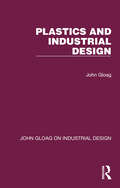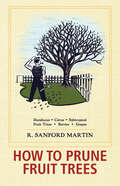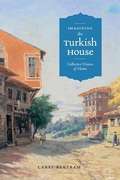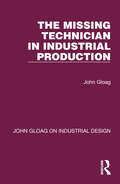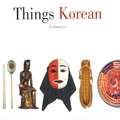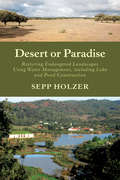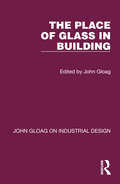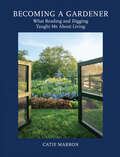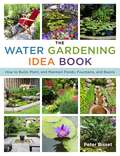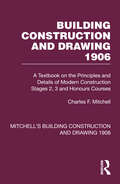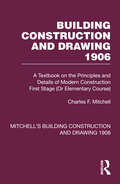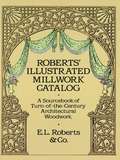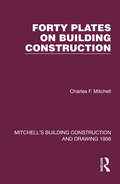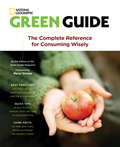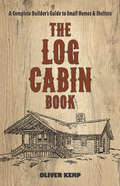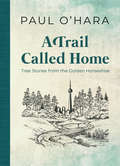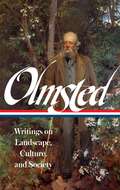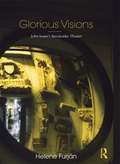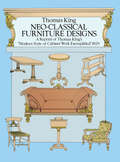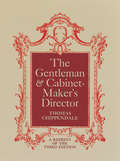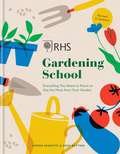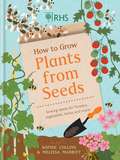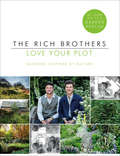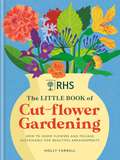- Table View
- List View
Plastics and Industrial Design (John Gloag On Industrial Design Ser.)
by John GloagOriginally published in 1945, Plastics and Industrial Design is a non-technical work of reference for manufacturers and designers who, after the Second World War were beginning to realize the possibilities that manufacturing with Plastics could bring. The different types of plastics and their uses is discussed, as is their impact on the design of manufactured articles. Whilst the extensive use of plastic may have fallen out of favour in recent years due to environmental concerns, this book reminds us that in their infancy they offered exciting manufacturing possibilities.
How to Prune Fruit Trees: Twentieth Edition
by Georgia SalesMake the right cut every time and maximize your fruit production—covers over forty varieties of trees from apples to almonds and plums to pomegranates. Note: If you would like to see the Echo Point paperback version of How to Prune Fruit Trees, please search ISBN 1626549540. While the act of pruning is simple enough, knowing where and when to prune can confound even experienced gardeners. For more than half a century, Robert Sanford Martin&’s How to Prune Fruit Trees has been the go-to guide for pruners of all levels of expertise. As one reviewer noted, &“This book simplifies what other books complicate. It has a small amount of text paired with line drawings that help break pruning tasks down into something you can easily understand.&” Martin has judiciously pruned his words to make his advice as clear and simple as possible. His guidance in the art of cutting back and thinning out has been responsible for the preservation of countless healthy trees and orchards. In this enhanced edition, additional information from H. H. Thomas&’s Pruning Made Easy explores the treatment of roots, side shoots, sub-laterals, standards, cordon trees, and other aspects of plant care. Well illustrated and clear, this book is an indispensable guide for year-round pruning success for both seasoned and amateur gardeners.
Imagining the Turkish House: Collective Visions of Home
by Carel Bertram"Houses can become poetic expressions of longing for a lost past, voices of a lived present, and dreams of an ideal future." <P><P>Carel Bertram discovered this truth when she went to Turkey in the 1990s and began asking people about their memories of "the Turkish house." The fondness and nostalgia with which people recalled the distinctive wooden houses that were once ubiquitous throughout the Ottoman Empire made her realize that "the Turkish house" carries rich symbolic meaning. In this delightfully readable book, Bertram considers representations of the Turkish house in literature, art, and architecture to understand why the idea of the house has become such a potent signifier of Turkish identity.
The Missing Technician in Industrial Production (John Gloag On Industrial Design Ser.)
by John GloagOriginally published in 1944, The Missing Technician shows how Industrial Design must begin at the very first stages of planning a product. The procedure of a design research committee is outlined – a type of practical co-ordination of the work of industrial designers and production technicians which proved highly effective. The value of materials like aluminium and plastic are emphasized, but equally the importance of glass and cast iron is stressed, especially when handled in new ways that 20th Century techniques made possible.
Things Korean
by O-Young Lee John HolsteinThings Korean is a useful guide to traditional life in Korea, presented in an accessible and attractive format. O-Young Lee, former Korean Minister of Culture gives us a survey of native objects from Korea, from totems(Changsung) to hair-pins(binyo), crock pots(Changdokdae) to temple bells(Jong), scissors(Kawi) to graves(mudon) explaining their significance and place in everyday Korean life.Each item in the book is listed under its English and Korean name; a glossary is provided to further assist the reader. Lavishly illustrated with more than 100 color illustrations, Things Korean is a magnificent celebration of Korean culture.
Desert or Paradise
by Sepp HolzerSepp Holzer farms steep mountainsides in Austria 5,000 feet above sea level. His farm is an intricate network of terraces, raised beds, ponds, and waterways, well covered with productive fruit trees and other vegetation, in dramatic contrast to his neighbors' spruce monocultures. Fans of Sepp Holzer have come from all over the world to see the productivity of his farm, a veritable permaculture paradise. His first book,Sepp Holzer's Permaculture, offers a detailed guide to what Holzer has achieved on his farm. Many readers might have wondered-but how can we achieve this on a global scale? Luckily, his newest book,Desert or Paradise, examines Holzer's core philosophy for increasing food production, earth health, and reconnecting mankind with nature, applied to reforestation and water conservation across the world. Through years of consultation with other countries, Holzer has developed a core philosophy for reconnecting mankind with nature even in arid or otherwise "lost-cause" regions. He details a process he calls "Grundierung," a term from painting meaning "base coat," which goes into great detail the importance of water, andDesert or Paradiseoffers his concept and guide to construction of large water reservoirs in arid, rainfall-dependent regions with examples from Greece, Turkey, Spain, and Portugal. Holzer describes the ecological and economic benefits of these changes, as well as the use of a variety of plant and animal species for further integration and regeneration of the surrounding areas, including reasons for reforestation and the cause and use of forest fires. Holzer also outlines his ten points of sustainable self-reliance and how these methods can help feed the world, such as the need to regulate the water budget, eliminate factory livestock farming, bring more fallow or unused areas into production, enlarge crop areas by using terracing and Holzer-style raised beds, regionalize instead of globalize, fight for land reform and engage in community building, go back to the ancient farming wisdom, and change the educational system. Also included are Holzer's ideas on beekeeping, humane slaughtering, nature spirits, the loss of roots in our society in general, and in politics especially.
The Place of Glass in Building (John Gloag On Industrial Design Ser.)
by John GloagOriginally published in 1943, The Place of Glass in Building is a comprehensive and compact survey of the structural uses of glass in 20th Century architecture. It gives the facts about the physical properties, the possibilities and the limitations of the glass in common use. It also deals with the attributes of specialised and decorative glass and provides detailed descriptions of the principal types which were manufactured in the UK. Intended for architectural students it may also be of interest to architects, for it is a condensed survey of the progress that has been made in this structural and decorative material.
Becoming a Gardener: What Reading and Digging Taught Me About Living
by Catie MarronA beautifully designed, full-color personal account of what it means to become a gardener, filled with specially commissioned color photography, watercolors, and fine art.To make her new house in Connecticut truly feel like home, Catie Marron decided to create a garden. But while she was familiar with landscape design, she had never grown anything. A dedicated reader with a lifelong passion for literature, Marron turned to the library of gardening books she’d collected to glean advice from a variety of writers on gardening and horticultural topics both grand and small. Marron’s quest to become a gardener, however, was about more than learning the basics about mulch or which plants work best in the shade. She sought something far more elusive: to identify the core qualities and characteristics that make a person a gardener and an understanding of what a garden could mean to her as it had to multitudes of other gardeners over the centuries.In Becoming a Gardener, Catie Marron chronicles her transformation into a gardener over the course of eighteen months, seeding the details of her experience with rich advice from writers as diverse as Eleanor Perényi and Karel Capek, Penelope Lively, and Jamaica Kincaid. As she digs deeper into her readings and works in the garden itself, Marron not only discovers the essence of gardening but in the words of Michael Pollan, “the endlessly engrossing ways that cultivating a garden attaches a body to the earth.”A delightful blend of informed opinion, personal reflection, and practical advice, Becoming a Gardener explores topics as varied as the composition of dirt, the agricultural wisdom of avid kitchen gardeners George Washington and Thomas Jefferson, the healing power of digging in the soil, and the beauty of finding solitude in nature. Throughout, Marron carefully plants special illustrated features, such as musings on the merits (and detriments) of the rose, essential tools, moonlight gardening, children’s books which feature gardens, and her favorite gardens around the world. Also included is an annotated list of recommended writers, books, and films related to gardens and gardening, and a monthly to-do calendar.Featuring specially commissioned illustrations by the Danish team All the Way to Paris, and stunning photographs by acclaimed photographer William Abranowicz that capture the pastoral beauty of Marron’s Connecticut garden, Becoming a Gardener is a very special and moving portrait of life and the enduring power of literature and nature that is sure to become an instant classic.
The Water Gardening Idea Book: How to Build, Plant, and Maintain Ponds, Fountains, and Basins
by Peter BissetLearn how to transform an ordinary backyard garden into a true showpiece. Originally published in 1924, Peter Bisset shares with readers timeless advice and tips for creating a variety of water gardens. After experiencing one, it's easy to see why these gardens hold such appeal; these splashing fountains and ponds make hot days seem cooler, and they also attract birds and butterflies to your backyard. Even tiny tabletop fountains offer soothing sounds to drown out a busy street or a noisy neighbor.The Water Gardening Idea Book gives in full detail all the practical information necessary for the selection, grouping, and successful cultivation of aquatic and other plants required in the making of a water garden and its surroundings. It's perfect for both amateurs and those with green thumbs looking to take their gardens to the next level. Readers will enjoy projects of varying difficulty, starting with simple container gardens to the large estate or park fountains and ponds. Whether you're interested in creating a casual pond or a formal fountain, with The Water Gardening Idea Book you'll be able to create them with confidence.
Building Construction and Drawing 1906: A Textbook on the Principles and Details of Modern Construction Stages 2, 3 and Honours Courses (Mitchell's Building Construction and Drawing)
by Charles F. MitchellOriginally published in 1881, but here reissuing the 1906 edition with a new introduction by Stephen J. Scaysbrook, the Mitchell’s Building and Construction Stage 2, 3 and Honours book offers an unparalleled insight into historic construction techniques and materials. Originally written to provide a concise handbook and guide for students and for practitioners, this reissue of Mitchell’s 1906 Advanced and Honours edition now provides a valuable addition to building pathology, allowing students and practitioners to research construction methods and materials pertinent to the period.
Building Construction and Drawing 1906: A Textbook on the Principles and Details of Modern Construction First Stage (Or Elementary Course) (Mitchell's Building Construction and Drawing)
by Charles F. MitchellOriginally published in 1881, but here reissuing the 1906 edition with a new introduction by Stephen J. Scaysbrook, the Mitchell Building and Construction books offer an unparalleled insight into construction techniques and materials. Originally written to provide a concise handbook and guide for students and for practitioners, this reissue of Mitchell’s 1906 First Stage or Elementary Course edition now provides a valuable addition to building pathology, allowing students and practitioners to research construction methods and materials pertinent to the period. Including over 1000 drawings, it is of no surprise to see Mitchell’s First Stage or Elementary edition start with a detailed explanation of the instruments and methods of drawing with pencil ink and tracing paper, emphasising the need to learn basic drawing skills and the need to think about a detail and the materials used to create a detail capable of lasting well over 100 years or more. The simple act of making a scale from a drawing with only one dimension may be lost to modern-day students, but not to Charles Mitchell, who describes the method and its use.
Roberts' Illustrated Millwork Catalog: A Sourcebook of Turn-of-the-Century Architectural Woodwork (Dover Woodworking)
by Roberts Co.When E. L. Roberts & Co. -- a Chicago-based wholesale manufacturer of architectural woodwork -- issued a catalog of its millwork products in 1903, the firm boasted that the publication included "more novel and useful features ... than any sash and door catalogue yet published," and that it was a book designed to satisfy "critical buyers who demand stylish and tasteful goods."This volume, reproduced directly from a rare turn-of-the-century Roberts catalog, displays a vast assortment of finely crafted products -- from window blinds, brackets, china closets, church fittings, doors, frames, gable finishes, linen closets, moldings, and office furniture to parquet floors, sashes, shingles, side boards, side lights, store fronts, wainscoting, and windows.Nearly 300 sharply defined line drawings and photographs also provide detailed close-ups of exquisitely carved rosettes, head blocks, grilles, arches, and other decorative accents. Included in these illustrations are superb views of late-Victorian interiors finished with ornately carved balusters and newel posts, paneled walls, exquisite filigree, lovely stained glass windows, and magnificent fireplace mantels.Here's a practical source of plans and ideas for architects, students of architectural history, carpentry enthusiasts, preservationists, restorationists, and anyone interested in the interior design and furnishings of a bygone era.
Forty Plates on Building Construction: A Textbook on the Principles and Details of Modern Construction First Stage (Or Elementary Course) (Mitchell's Building Construction and Drawing #3)
by Charles F. MitchellOriginally published in 1891, this volume was a companion volume to the Elementary and Advanced volumes of Building Construction and Drawing. The exquisite technical drawings give a technical level of detail which is invaluable for the study of late 19th Century construction methods and materials and cover brickwork and masonry, carpentry, joinery, plumbing, roof and iron work.
Green Guide: The Complete Reference for Consuming Wisely
by Meryl StreepPaper or plastic? Organic or conventional? The Green Guide is here to help, with the concepts and choices for Earth-conscious living. Presented in concise, information-packed chapters, this up-to-the-minute resource touches on every aspect of our lives, from grocery shopping to housecleaning to work, travel, and investing, enabling consumers to make informed decisions and simple changes that impact the planet in big ways. Easy-to-follow information and hundreds of fascinating sidebars, fact boxes, and other key elements recommend how you can replace unhealthy and environmentally damaging practices and products with more wholesome, comfortable, and aesthetically pleasing alternatives. Neither scholarly nor scare-mongering in tone, the lively text has been written in partnership with a board of noted experts, offering readers the most authoritative, engaging, comprehensive, and in-depth reference of its kind. Created by two of the strongest brands in conservation and the environment, and drawn from more than ten years of reputable coverage in The Green Guide newsletter, on-line and in print, this comprehensive resource is destined to become a must-have for millions of families and the first name in household reference books in this up-and-coming category
The The Log Cabin Book: A Complete Builder's Guide to Small Homes and Shelters
by Oliver KempThis vintage guide from over a century ago offers timeless, practical advice on building log cabins. Plans and directions for simple structures are easy enough for amateurs to follow; time and inclination are the only necessary elements. Each of the designs has been tested and allows numberless alterations to suit the builder's tastes and requirements. Instructions range from selecting a site and safe, efficient methods of cutting down trees for building materials to building an ice house and boathouse to furnishing and decorating interiors. Photographs and drawings provide clear images for a variety of wilderness homes, including floor plans for The Block House, Wildwood, Crow's Nest, Idlewild, and other rustic retreats. Rich in nostalgic charm as well as useful applications, this manual offers priceless guidance to handymen, woodworkers, and hunters as well as those interested in small houses, construction, and home history and seekers of off-the-grid, environmentally friendly living.
A Trail Called Home: Tree Stories from the Golden Horseshoe
by Paul O'HaraAn exploration of trees in the Golden Horseshoe and the stories they tell. Trees define so much of Canadian life, but many people, particularly in the Golden Horseshoe area of Ontario, don’t know that much about them. Granted, it is harder here: there are more trees that are native to this area than anywhere else in Canada. The great storytellers of the landscape, trees are looking glasses into the past. They speak of biology, ecology, and geology, as well as natural and human history. Through a greater understanding of trees, we can become more rooted to the land beneath our feet, and our place in it.
Frederick Law Olmsted: Writings on Landscape, Culture, and Society
by Frederick Law Olmsted Charles BeveridgeThe biggest and best single-volume collection ever published of the fascinating and wide-ranging writings of a vitally important nineteenth century cultural figure whose work continues to shape our world today. Seaman, farmer, abolitionist, journalist, administrator, reformer, conservationist, and without question America's foremost landscape architect and urban planner, Frederick Law Olmsted (1822-1903) was a man of unusually diverse talents and interests, and the arc of his life and writings traces the most significant developments of nineteenth century American history. As this volume reveals, the wide-ranging endeavors Olmsted was involved in--cofounding The Nation magazine, advocating against slavery, serving as executive secretary to the United States Sanitary Commission (precursor to the Red Cross) during the Civil War, championing the preservation of America's great wild places at Yosemite and Yellowstone--emerged from his steadfast commitment to what he called "communitiveness," the impulse to serve the needs of one's fellow citizens. This philosophy had its ultimate expression is his brilliant designs for some of the country's most beloved public spaces: New York's Central Park, Prospect Park in Brooklyn, Boston's "Emerald Necklace," the Biltmore Estate in North Carolina, the grounds of the U.S. Capitol, garden suburbs like Chicago's Riverside, parkways (a term he invented) and college campuses, the "White City" of the 1893 World's Columbian Exposition, and many others. Gathering almost 100 original letters, newspaper dispatches, travel sketches, essays, editorials, design proposals, official reports, reflections on aesthetics, and autobiographical reminiscences, this deluxe Library of America volume is profusely illustrated with a 32-page color portfolio of Olmsted's design sketches, architectural plans, and contemporary photographs. It also includes detailed explanatory notes and a chronology of Olmsted's life and design projects.From the Hardcover edition.
Glorious Visions: John Soane's Spectacular Theater
by Helene FurjánFocusing on the house and museum and its considerable collections of architectural fragments, models, drawings folios and publications, this book is about thirteen Lincoln’s Inn Fields in London, England, built in the early 1800s by the renowned eighteenth-century architect Sir John Soane. The book maps the influences, references, connections, extensions, and productions at play in Soane’s house-museum. The house, still a public museum, was highly original in its period, and it continues to influence and impress architects and historians alike. Today’s visitor is confronted by a dense, complex series of spaces, a strange accumulation of rooms, objects and effects. This book examines the ways in which Soane enlisted light, shadow, color, fiction and narrative, vistas, spatial complexity, the fragment, and the mirror to produce a spectacular space.
Neo-Classical Furniture Designs: A Reprint Of Thomas King's Modern Style Of Cabinet Work Exemplified, 1829
by Thomas KingInfluential guide displays over 300 Grecian designs: fire screens, sofas, couches, chairs, footstools, commodes, sideboards, washstands, bedsteads,and many other items.
The Gentleman and Cabinet-Maker's Director
by Thomas ChippendaleThomas Chippendale (1718-79) was the most famous and most skilled of England's master cabinet-makers. So synonymous with excellence in design and craftsmanship was he that his name has been given to the most splendid period of English furniture design.In 1774, Chippendale issued a catalogue of all his designs, a magnificent compilation of 160 engraved plates representing the prevailing furniture styles, particularly the French (Louis XXV), Gothic, and Chinese-manner pieces for which he was best known. The Gentleman and Cabinet-Maker's Director, the most important and thorough catalogue of furniture designs that had ever been published in England, was enormously influential, spreading quickly throughout the Continent and the colonies and guiding the style and construction of furniture everywhere. A second edition was formed the following year, and a third in 1762. Today this classic collection is a very rare and highly valued work.This volume is an unaltered and unabridged republication of the 1762 edition of The Gentleman and Cabinet-Maker's Director. The articles of furniture depicted are extremely varied: chairs, sofas, canopy and dome beds, window cornices, breakfast tables, shaving tables, commodes, chamber organs, cabinets, candle stands, cisterns, chimney pieces, picture frames, frets, and other decorations. The plates contain elegant drawings that show the unique combination of solidity of construction and lightness and grace that was the Chippendale trademark, along with many construction diagrams, elevations, and enlargements of moldings and other details. In addition to the plates, this volume also includes a supplement of photographs of sixteenth-century Chippendale-style pieces, including some executed by Chippendale, complete captions to the photos, and a short biographical sketch of Chippendale by N. I. Bienenstock, editor of Furniture World.The Gentleman and Cabinet-Maker's Director is an indispensable guide for antiquarians, furniture dealers, and collectors, and a treasury of ideas for today's designers. Art lovers and other readers will also find it a delightful browsing book.
RHS Gardening School: Everything You Need to Know to Get the Most from Your Garden
by Simon Akeroyd Dr Ross BaytonKeen amateur gardeners and aspiring professionals can learn from the expertise of the RHS with this handy guide.It doesn't matter if you're an old hand at gardening or just starting out, there are always things to discover and opportunities to improve, whether it's mastering a new technique or brushing up on your botany.RHS Gardening School is the perfect guide for gardeners who want to learn. Inside you'll find chapters on:Understanding plants Everyday garden care Problem solvingPlanting designGardening through the yearand much more. Hands-on guidance and step-by-step instructions explain topics such as pruning, pest and diseases, weed removal and caring for lawns. Expert gardeners explain the underlying principles in plain English, while clear diagrams and beautiful photographs inspire and inform.Become a better, smarter, more productive gardener with this complete guide to horticulture in one handy book.
RHS How to Grow Plants from Seeds: Sowing seeds for flowers, vegetables, herbs and more
by Sophie CollinsHow To Grow Plants From Seeds does away, once and for all, with the idea that there's something difficult about growing direct from seed. There's no need to rely on the professionals to raise seedlings for you: seeds are not only cheap to buy and environmentally friendly but, if you follow a few basic rules, they're also fantastically rewarding, not least because a single packet will usually leave you with plenty of spares to swap with fellow enthusiasts.Whether you're a novice or an experienced gardener, if you want to nurture an impressive cutting garden or aim to have a bounteous harvest of fruit and vegetables, here's what you need to know, presented in a straightforward and accessible way. You'll discover the basic rules for different seeds, their sowing preferences (Indoor, under cover or direct- to-plot? Surface-sow or cover up? Water or spray?), how long they take to germinate, and how to prick out, pot on and raise your infant plants to become sturdy, productive adults.The book opens with a basic primer showing how seeds work, to give every grower the best chance at success. This is followed by extensive chapters on raising food and flowers from seed with plenty of detailed plant profiles included, and finally there's a guide to collecting seeds from your plants and how to save and swap - so that you, too, can become a seed evangelist.
Love Your Plot: Gardens Inspired by Nature: tips and tricks to transform your garden into a perfect paradise
by Harry Rich David RichA full-colour and beautifully illustrated guide into transforming your existing garden or plot of land into a modern, visually-stunning - but also easily achieved and maintained - space. Including full-colour images and tips and tricks from gardening experts and Chelsea Flower Show Gold Medal winners Harry and David Rich as well as suggestions tailored to various garden types, this is a must-read for anyone wanting that little bit of paradise to escape to at home...'Full of creativity and good ideas... plenty here to whet the appetite of an aspiring garden designer' -- Gardens Illustrated'Love Your Plot is a book to read right through and then dip into again to bring a particular idea or method of working back into focus.' -- Garden Design Journal'Very inspiring' -- ***** Reader review'This book is a joy to own, beautifully written and illustrated. It's crammed with information, easy to read and fantastic inspiration' -- ***** Reader review'Awesome book. Clear and easy to understand with lots of useful tips' -- ***** Reader review'Best book ever for any garden designer - an excellent read' -- ***** Reader review'A gold mine of garden design wisdom' -- ***** Reader review*****************************************************************************************************Fusing conceptual garden design with the beauty of the natural landscape, twice Chelsea Flower Show Gold Medal winners and stars of BBC's Garden Rescue Harry and David Rich are here to show you how you can transform your outdoor space into a beautiful Eden, no matter what plot you have.In Love Your Plot Harry and David set out to help you transform your outdoor space into an inspiration green haven by making nature work for you. Fusing different outdoor elements, such as coastal and woodland landscapes, alongside key design principles, they will show you how to create a modern, practical and visually stunning outdoor space that will awe and inspire - and that is crucially easy to maintain.Complete with practical tips, unique sketches and designs, planting suggestions and stunning full-colour visuals, Love Your Plot will have you reaching for the spade and wellies in no time at all to create your own Eden, no matter what plot you've got.
RHS The Little Book of Cut-Flower Gardening: How to grow flowers and foliage sustainably for beautiful arrangements
by Holly FarrellFlowers brighten our homes, our lives and, when they are homegrown, they also brighten our gardens - not just for us, but also for the buzzing wildlife that loves their nectar. Growing your own flowers gives the huge satisfaction of harvesting something from a plant you have nurtured, and brings a greater connection with nature and the seasons. It also allows you to have a house full of flowers at a fraction of the cost of buying them, all with a sustainable, positive environmental impact. RHS The Little Book of Cut-Flower Gardening is the perfect introduction to growing your own blooms. Whether your cut-flower patch is a handful of pots or half an allotment, you'll find accessible information on successful and sustainable growing, to keep your plot healthy and as productive as possible. As well as introductory chapters on planning and gardening basics, there are details on how to cut your flowers and extend their vase life,and how to dry flowers for everlasting arrangements.More than just flowers, the directories break down the blooms and foliage into their different groups. There are sections on annuals from seed, such as love-in-a-mist, ammi and sweet peas; growing bulbs and tubers such as tulips and dahlias; perennials for flower and foliage, such as lady's mantle, lavender, roses, apple mint and ornamental grasses; and shrubs and trees for foliage, flower, spring blossom and colourful winter stems.
RHS The Little Book of Cut-Flower Gardening: How to grow flowers and foliage sustainably for beautiful arrangements
by Holly FarrellFlowers brighten our homes, our lives and, when they are homegrown, they also brighten our gardens - not just for us, but also for the buzzing wildlife that loves their nectar. Growing your own flowers gives the huge satisfaction of harvesting something from a plant you have nurtured, and brings a greater connection with nature and the seasons. It also allows you to have a house full of flowers at a fraction of the cost of buying them, all with a sustainable, positive environmental impact. RHS The Little Book of Cut-Flower Gardening is the perfect introduction to growing your own blooms. Whether your cut-flower patch is a handful of pots or half an allotment, you'll find accessible information on successful and sustainable growing, to keep your plot healthy and as productive as possible. As well as introductory chapters on planning and gardening basics, there are details on how to cut your flowers and extend their vase life,and how to dry flowers for everlasting arrangements.More than just flowers, the directories break down the blooms and foliage into their different groups. There are sections on annuals from seed, such as love-in-a-mist, ammi and sweet peas; growing bulbs and tubers such as tulips and dahlias; perennials for flower and foliage, such as lady's mantle, lavender, roses, apple mint and ornamental grasses; and shrubs and trees for foliage, flower, spring blossom and colourful winter stems.
